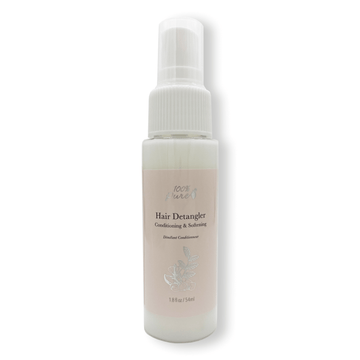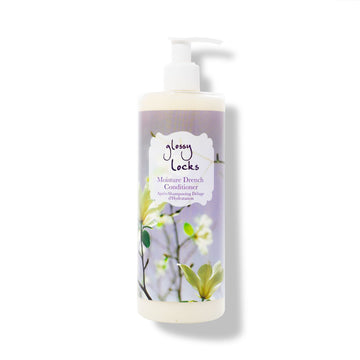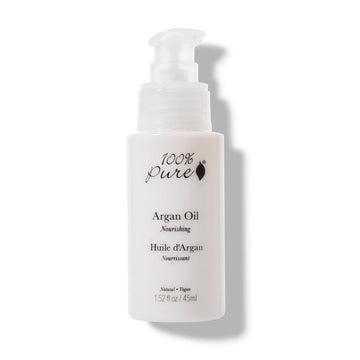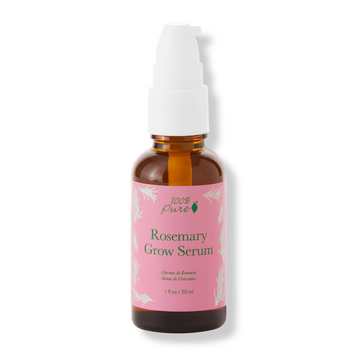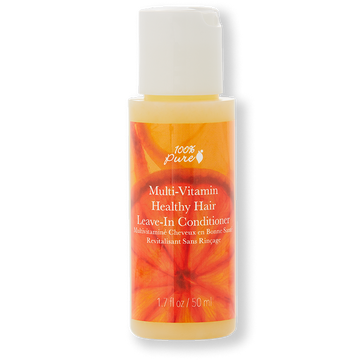Understanding the Real Causes of Frizz and How to Achieve Smooth, Hydrated Hair That Lasts
Posted on March 12, 2025 Written by: 100% PURE®
You’ve just finished conditioning your hair, expecting soft, smooth strands—yet minutes later, frizz appears. Sound familiar? Many people experience frizzy hair even after using what they believe to be the best conditioner, leading to frustration and confusion.
The truth is, conditioner alone isn't always enough to combat frizz. Several factors, including hair hydration levels, product buildup, environmental conditions, and heat damage, can impact how well your hair absorbs and retains moisture.
In this blog, we’ll break down why frizz persists despite conditioning and provide expert-backed solutions to help you achieve smoother, more manageable hair.
Looking for frizz-fighting products? 100% PURE offers natural, silicone-free hair care solutions designed to lock in moisture, prevent frizz, and promote long-lasting hair health.
Let’s dive into the common reasons why your hair stays frizzy even after using conditioner—and how to fix it!

Section 1: Why Hair Remains Frizzy After Using Conditioner
1. Lack of Moisture and Hydration
Frizz is often a sign of dehydration. When the cuticle (outer layer of the hair shaft) is raised, it allows moisture from the air to penetrate and swell the strands, resulting in frizz and flyaways.
While a conditioner helps hydrate hair, it may not be enough if your strands are:
- Naturally dry or porous
- Frequently exposed to heat styling
- Damaged from chemical treatments or bleaching
💡 Solution:
✔ Incorporate a leave-in conditioner or deep conditioning treatment to provide long-lasting hydration.
✔ Try 100% PURE Conditioning Detangler for an extra moisture boost—this lightweight formula smooths the cuticle and prevents moisture loss.
2. Incorrect Use of Conditioner
Using conditioner the wrong way can significantly reduce its effectiveness.
Common Mistakes That Lead to Frizz:
❌ Applying conditioner only to the roots instead of focusing on mid-lengths and ends (where frizz occurs most).
❌ Rinsing out conditioner too quickly, not allowing it to penetrate the hair shaft.
❌ Skipping leave-in conditioners, which seal in moisture and protect against dryness.
💡 Solution:
✔ Apply conditioner from mid-lengths to ends and let it sit for at least 2-3 minutes before rinsing.
✔ Use 100% PURE Glossy Locks Moisture Drench Conditioner—a rich, ultra-nourishing formula that smooths and softens frizz-prone hair.
3. Environmental Factors (Humidity & Weather Conditions)
🌡 Humidity is one of the biggest culprits behind frizz—especially if your hair is dry or damaged. When the air is humid, your hair absorbs excess moisture, causing it to expand and become frizzy.
💡 Solution:
✔ Use anti-frizz serums and hydrating shampoos to create a protective barrier.
✔ 100% PURE Glossy Locks Moisture Drench Shampoo is a sulfate-free formula that gently cleanses while locking in moisture, helping your hair stay sleek even in humid conditions.
4. Product Build-Up
🚫 Over time, silicone-based conditioners and styling products can build up on the hair shaft, preventing proper moisture absorption. This leads to dull, dry, and frizzy hair—even if you're conditioning regularly.
💡 Solution:
✔ Use a clarifying shampoo once every 2-4 weeks to remove residue and reset your hair.
✔ Avoid heavy silicones and sulfates that can dry out your strands over time.
5. Heat Damage
🔥 Frequent heat styling (flat irons, curling wands, and blow dryers) weakens the cuticle, making hair rough, brittle, and prone to frizz. Even if you condition, damaged cuticles won’t retain moisture properly.
💡 Solution:
✔ Reduce heat styling and always use a heat protectant before using hot tools.
✔ Apply 100% PURE Argan Oil—a lightweight, deeply nourishing oil that repairs and strengthens damaged hair, reducing frizz and restoring smoothness.
6. Washing with Hot Water
🚿 Hot water strips the scalp and hair of natural oils, leaving it dry and more prone to frizz. While a warm rinse may feel relaxing, it can weaken the hair cuticle and lead to moisture loss.
💡 Solution:
✔ Always rinse with cool or lukewarm water to help seal the cuticle and lock in moisture.
✔ After showering, apply 100% PURE Rosemary Grow Serum to strengthen and nourish your hair from the root.
Section 2: How to Combat Frizz Effectively
Now that we understand why frizz persists even after using the best conditioner, let's explore proven solutions to combat frizz and keep your hair smooth, soft, and hydrated.
1. Use a Leave-In Conditioner
Even the best rinse-out conditioner might not be enough to lock in moisture throughout the day. Leave-in conditioners provide an extra layer of hydration and act as a protective barrier against humidity and environmental factors.
💡 Why It Works:
✅ Prevents moisture loss by sealing the hair cuticle.
✅ Helps detangle and smooth strands, reducing frizz.
✅ Works as a lightweight styling aid for softer, shinier hair.
✨ Try: 100% PURE Multi-Vitamin Healthy Hair Leave-In Conditioner – A lightweight, hydrating formula that provides lasting moisture and smoothness without weighing hair down.
2. Incorporate Anti-Frizz Styling Products
Your conditioner provides essential hydration, but to lock in moisture and control flyaways, a styling product like a serum or oil is essential.
💡 Why It Works:
✅ Creates a protective barrier against humidity.
✅ Helps smooth flyaways and adds shine.
✅ Reduces static and frizz caused by environmental factors.
✨ Try: 100% PURE Pro-Vitamin B5 Smoothing Hair Serum – A rich yet lightweight oil that deeply nourishes the hair while sealing in moisture for long-lasting frizz control.
3. Switch to Sulfate-Free Products
🚫 Sulfates are harsh cleansing agents found in many commercial shampoos, but they can strip your hair of its natural oils, leaving it dry, brittle, and more prone to frizz.
💡 Why It Works:
✅ Preserves the hair’s natural moisture balance.
✅ Prevents excessive drying and cuticle roughness.
✅ Ideal for all hair types, especially dry, curly, or chemically treated hair.
✨ Try: 100% PURE Glossy Locks Moisture Drench Shampoo – A sulfate-free, ultra-hydrating shampoo that gently cleanses while infusing hair with nourishing botanical extracts.
4. Avoid Overwashing
Washing your hair too often removes its natural oils, leaving it dry and vulnerable to frizz.
💡 Why It Works:
✅ Allows your scalp to produce natural oils that keep hair moisturized.
✅ Prevents over-drying and cuticle damage.
✅ Helps maintain longer-lasting hydration between washes.
🛑 Solution: Limit washing to 2-3 times per week and always follow up with a moisturizing conditioner to prevent frizz.
5. Use a Microfiber Towel
🚿 Traditional cotton towels are too rough on the hair and create friction, which can raise the cuticle and increase frizz.
💡 Why It Works:
✅ Reduces friction and static while drying the hair.
✅ Helps absorb excess water without disrupting the hair cuticle.
✅ Ideal for curly and frizz-prone hair.
🛑 Solution: Use a microfiber towel or a soft cotton T-shirt to gently squeeze out excess water without roughing up your strands.
6. Protect Against Heat Damage
Frequent heat styling can cause the hair cuticle to weaken, leading to dryness, roughness, and frizz. If you must use heat tools, always apply a heat protectant to minimize damage.
💡 Why It Works:
✅ Creates a protective barrier to shield hair from heat.
✅ Helps maintain moisture and elasticity.
✅ Reduces split ends and frizz caused by heat exposure.
✨ Try: 100% PURE Rosemary Grow Serum – A nutrient-rich serum that strengthens the hair shaft, promotes healthy growth, and prevents heat damage.
7. Trim Split Ends Regularly
Split ends contribute to frizz by making hair look rough and dry. Trimming them regularly keeps hair smooth, healthy, and more manageable.
💡 Why It Works:
✅ Removes damaged, frayed ends that make hair appear frizzy.
✅ Helps maintain hair shape and structure.
✅ Encourages healthier growth by preventing split ends from traveling up the strand.
🛑 Solution: Trim your hair every 6-8 weeks to keep it healthy and frizz-free.

Section 3: Key Takeaways – Why Conditioner Alone Won’t Stop Frizz
Even if you use the best conditioner, frizz is a multi-faceted issue that requires a full hair care approach. Here's a quick recap of the causes of frizz and the best solutions to keep your hair smooth and hydrated:
Frizz Cause |
Solution |
Recommended 100% PURE Products |
|---|---|---|
Lack of hydration |
Use a leave-in conditioner |
|
Incorrect conditioner use |
Apply correctly & leave in longer |
|
Humidity |
Use anti-frizz products & serums |
|
Product build-up |
Clarify with gentle shampoo |
|
Heat damage |
Reduce heat styling & nourish hair |
🔹 Universal Tip: Conditioner alone won’t eliminate frizz—you need a complete hair care routine that includes hydration, styling products, gentle washing techniques, and regular maintenance to achieve truly smooth, frizz-free hair.
Section 4: Frequently Asked Questions (FAQs)
Still wondering why frizz persists even after using the best conditioner? Here are some common questions and expert-backed answers to help you get smooth, frizz-free hair.
1. Why does my hair stay frizzy even after conditioning?
Conditioner helps hydrate and soften hair, but it cannot fix underlying causes of frizz such as:
-
Lack of moisture retention due to high porosity.
-
Humidity, which causes hair to absorb excess moisture from the air.
- Heat damage, which weakens the hair’s structure, making it more prone to frizz.
2. Can using too much conditioner make hair frizzy?
Yes! Over-conditioning can backfire, especially if your conditioner contains silicones. These create product buildup, which can:
❌ Weigh down the hair, making it look dull.
❌ Block moisture from penetrating the strands, leading to frizz over time.
3. How do I keep my hair from getting frizzy in humidity?
🌡️ Humidity is one of the biggest triggers for frizz because it causes dry hair to absorb excess moisture from the air, making strands swell and puff up.
4. What type of conditioner is best for frizzy hair?
Frizz-prone hair needs a moisture-rich, silicone-free conditioner that:
✅ Hydrates deeply without leaving buildup.
✅ Smooths the cuticle to prevent moisture loss.
✅ Strengthens the hair shaft to reduce breakage.
5. Should I rinse conditioner out completely or leave some in?
It depends on your hair type and level of dryness:
✔ For fine or oily hair: Rinse out completely to avoid weighing down the strands.
✔ For dry or frizz-prone hair: Leave a small amount of conditioner in to help retain moisture.
✔ For extreme frizz: Use a leave-in conditioner for added hydration without buildup.
Final Thoughts
Frizz isn’t just about conditioner—it’s about how you use it, what other products you incorporate, and your overall hair care routine.
✨ Key Takeaway: To control frizz, focus on moisture retention, humidity protection, and minimizing heat and product buildup.
🌿 Want smoother, healthier hair? 100% PURE’s natural hair care products are designed to deeply hydrate, protect, and repair hair naturally—without harmful chemicals.
- Tags: March-2025
We carefully hand-select products based on strict purity standards, and only recommend products we feel meet this criteria. 100% PURE™ may earn a small commission for products purchased through affiliate links.
The information in this article is for educational use, and not intended to substitute professional medical advice, diagnosis, or treatment and should not be used as such.












